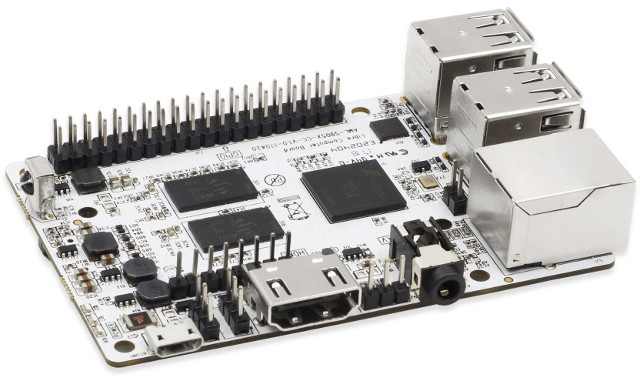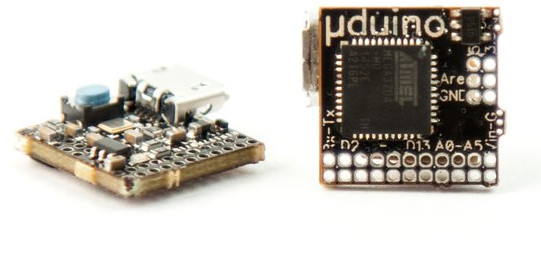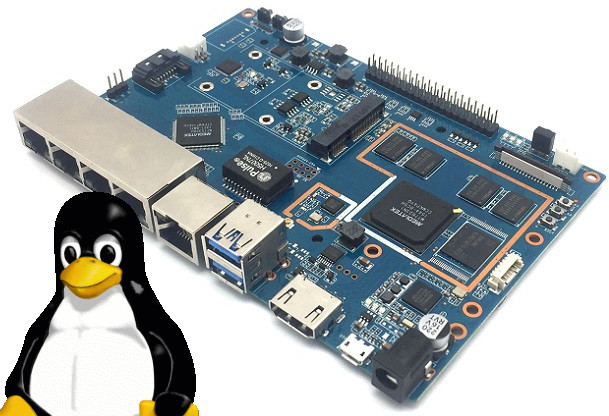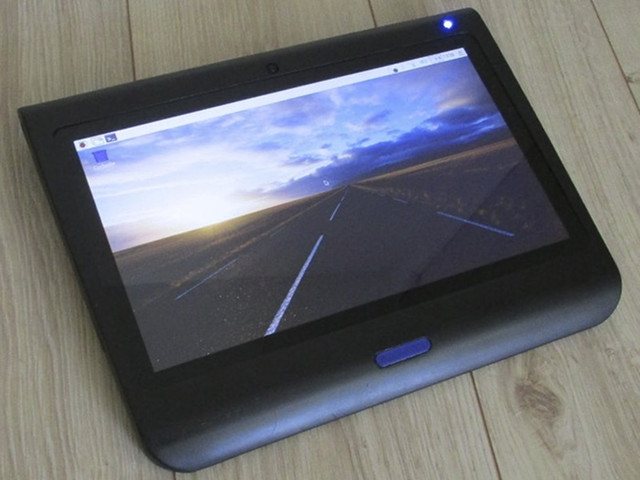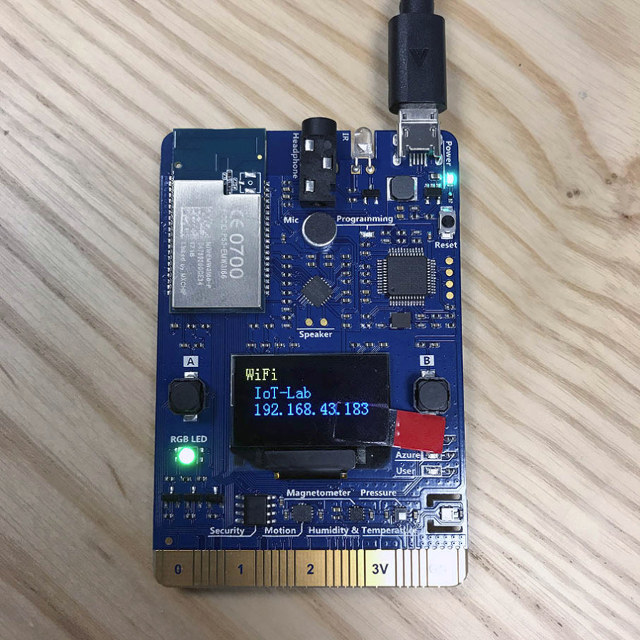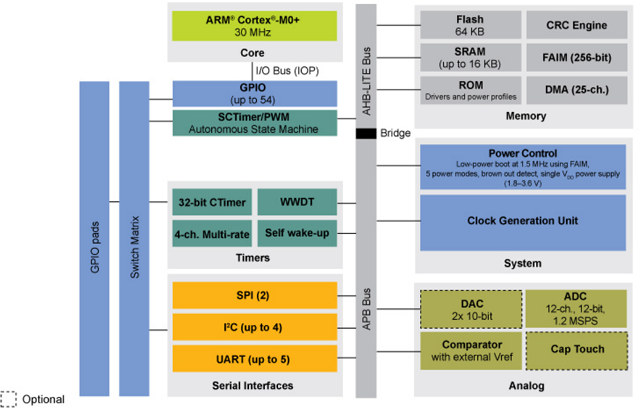Up to now there were two notable Amlogic S905(X) development boards: ODROID-C2 and Khadas Vim. Shenzhen Libre Technology Co., Ltd, a Shenzhen startup, is about to bring one more to the market with Le Potato board, aka AML-S905X-CC, powered by Amlogic S905X processor with 1 or 2 GB RAM, and in a form factor similar to the Raspberry Pi 3 board. Le Potato /AML-S905X-CC board specifications: SoC – Amlogic S905X quad core ARM Cortex-A53 processor @ 1.5 GHz with penta core ARM Mali-450MP GPU, and Amlogic Video Engine 10 System Memory – 1GB or 2GB DDR3 RAM Storage – 1x micro SD Card slot with UHS SDR104 support, eMMC module connector with HS400 support Video Output – HDMI 2.0 Port, 3.5mm TRRS “AV” jack with CVBS (480i / 576i) Audio Output – HDMI, AV jack (stereo audio), SPDIF output header, and I2S header Connectivity – 10/100M Ethernet USB – 4x […]
μduino May Be the World’s Smallest Arduino Board (Crowdfunding)
OLIMEXINO-85S may have held the title of the world’s smallest Arduino (compatible) board for the last few years, being barely bigger than a micro SD card as it measures about 16.9 x 12.7 mm, but there’s a new mini champion in town with μduino board measuring just 12 x 12 mm. μduino board specifications: MCU – Microchip Atmel ATMEGA32U4 8-bit AVR microcontroller @ 16 MHz with 2,560 bytes of RAM, 32KB flash, and 1024 bytes of EEPROM (Arduino Leonardo compatible) I/Os 6x Analog I/O ports 14x Digital I/O ports (including Rx/Tx) including 7x PWM 1x Analog reference voltage port 1.27mm pitch Programming / Debugging – 1x micro USB port; 6-pin ICSP programming ports (load custom bootloaders, program other boards, etc) Misc – Status LED, reset button Power Supply – 5V via micro USB port; 5V voltage regulator (accepts up to 16V DC); 2x 5V ports; 2x ground ports Dimensions – 12x […]
Banana Pi BPI-R2’s U-boot & Linux 4.4 Source Code & MediaTek MT7623N Datasheet Released
Banana Pi BPI-R2 is a multimedia router board powered by MediaTek MT7623N quad core processor with 2GB RAM, 5 Gigabit Ethernet ports, up to two SATA ports, two USB 3.0 ports, HDMI output, and I/O headers. The board is not for sale yet, but the company has recently released the source code with U-boot and Linux 4.4.70, as well as a datasheet for MediaTek MT7623N processor. The source code can be found on Github, so let’s see if we can build it:
|
1 2 3 4 5 6 7 8 9 10 11 12 13 14 15 16 17 18 19 20 21 22 23 |
git clone https://github.com/BPI-SINOVOIP/BPI-R2-bsp cd BPI-R2-bsp/ sudo apt install gcc-arm-linux-gnueabihf ./build.sh ./build.sh NOTICE: new build.sh default select BPI-R2-720P and pack all boards supported boards: BPI-R2-720P BPI-R2-720P configured. Now run `make` This tool support following building mode(s): -------------------------------------------------------------------------------- 1. Build all, uboot and kernel and pack to download images. 2. Build uboot only. 3. Build kernel only. 4. kernel configure. 5. Pack the builds to target download image, this step must execute after u-boot, kernel and rootfs build out 6. update files for SD 7. Clean all build. -------------------------------------------------------------------------------- Please choose a mode(1-7): 1 |
After a couple of minutes, the build would end with:
|
1 2 3 4 5 |
usr/lib/u-boot/bananapi/ usr/lib/u-boot/bananapi/bpi-r2/ usr/lib/u-boot/bananapi/bpi-r2/BPI-R2-720P-2k.img.gz Build success! |
For the very last step, it asks you to login as root / sudoer, which it should not do… But we end up with the images, so at least it builds:
|
1 2 3 4 5 6 7 8 |
ls -lh ./SD/ total 27M drwxrwxr-x 2 jaufranc jaufranc 4.0K Jun 28 10:46 100MB -rw-rw-r-- 1 jaufranc jaufranc 22M Jun 28 10:46 4.4.70-BPI-R2-Kernel.tgz -rw-rw-r-- 1 jaufranc jaufranc 151K Jun 28 10:46 BOOTLOADER-bpi-r2.tgz drwxrwxr-x 3 jaufranc jaufranc 4.0K Jun 28 10:46 BPI-BOOT -rw-rw-r-- 1 jaufranc jaufranc 4.8M Jun 28 10:46 BPI-BOOT-bpi-r2.tgz drwxrwxr-x 4 jaufranc jaufranc 4.0K Jun 28 10:46 BPI-ROOT |
MediaTek has also been active by committing patchsets for MT7623 to the Linux Kernel Mailing List, so mainline Linux is an eventual possibility for […]
Diskio Pi 13.3″ Touch Panel Display Kit is Designed for Raspberry Pi and ODROID Boards (Crowdfunding)
If your project requires a touch panel, there are plenty of solutions for Raspberry Pi and ODROID boards, with Hardkernel even selling ODROID-VU8C fully integrated touch panel display. However, most display kits require you to make your own case, and feature smaller displays with lower resolution. One developer has however come up with Diskio Pi, a higher-end touch panel kit with a 13.3″ Full HD display that works with the most popular Raspberry Pi and ODROID boards. Diskio Pi specifications: Display – 13.3″ AUO TFT IPS display with 1920×1080 resolution connected via a 30-pin eDP connector ; 330 cd/m2 brightness; 85° viewing angles in all directions. Touch panel – 10-point capacitive touch; G/G structure; USB 2.0 interface; ≥6H surface hardness. Main board: HDMI to eDP driver Stereo sound amplifier USB 2.0 hub with 3x ports: 2x external + 1x internal Battery balance circuit (3S/3S2P) Expansion – Various headers for prototyping […]
MXCHIP AZ3166 IoT Developer Kit is Designed to Work with Microsoft Azure
MXCHIP is a Shanghai based company designing and manufacturing WiFi IoT modules such as EMW3165, which has now made a development board based on their EMW3166 STM32+ Cypress module – called MXChip AZ3166 – specifically designed for Microsoft Azure cloud computing platform. MXChip AZ3166 board specifications: Wireless Module – EMW3166 WiFi module with STM32F412 ARM Cortex M4F MCU @ 100 MHz with 256KB SRAM,1MB+2MB SPI Flash, Cypress BCM43362 WiFi chip Display – 128×64 OLED display Audio – Audio codec, built-in microphone, and 3.5mm heaphone jack Sensors – Motion sensor, magnetometer, atmospheric pressure sensor, temperature and humidity sensor Expansion – Finger extension interface with 25 external I/O pins including GPIOs, I2C, I2S, UART, ADC, Reset, 3.3V, and GND Debugging – DAP Link emulator USB – 1x Micro USB port for power, programming, debugging Misc – 2x user buttons; 1x RGB light; 3x working status indicator; IR emitter; Security encryption chip Power Supply […]
IceZero Lattice iCE40 FPGA Board is Designed for Raspberry Pi Zero
Yesterday, we reported about Olimex’s open source hardware iCE40HX8K-EVB board with a Lattice iCE40 (HX8K) FPGA, and today, another iCE40 FPGA board, also open source hardware, appeared in my news feed with Trenz Electronic’s IceZero board specifically designed to be programmed using a Raspberry Pi Zero board. IceZero board specifications: FPGA – Lattice ICE40HX4K with 3520 logic gates, and 80 Kbit memory Storage – SPI Flash for FPGA self-configuration Misc – 3x User LEDs; User Clock: 100 MHz Expansion – 4x unpopulated PMOD Connectors; 40-pin Raspberry Pi female header Dimensions – 56 x 30.5mm (Raspberry Pi HAT Compatible) The board is supported by icoTC open source FPGA toolchain for Windows and Linux, which you can use in Raspberry Pi Zero (W), and other RPi board with a 40-pin header running Raspbian, as explained in that simple example in Github. Trenz electronic only shared part of the documentation, but you’ll find […]
NXP Unveils LPC84x ARM Cortex M0+ MCU Family, and LPCXpresso845-MAX Evaluation Board
NXP Semiconductors has expanded LPC800 series MCUs with the new LPC84x family of 32-bit ARM Cortex-M0+ microcontroller said to offer 10 times the performance, three times more power saving savings, and 50 percent smaller code-size than 8- or 16-bit microcontrollers. Key features of LPC84x MCU family (LPC844 / LPC845): MCU Core – ARM Cortex-M0+ core @ 30 MHz with advanced power optimization RAM – 16 kB RAM (Logic for Bit banding across all of SRAM) Storage – 64 kB Flash, small 64-byte page size suitable for EEPROM emulation Peripherals Timers – 32-bit CTimer, WWDT, 4-channel multi-rate, SCTimer/PWM Serial Interfaces – Up to 4x I2C, 2x SPI, up to 5x UART Analog Interfaces – 12 ch, 12-bit ADC up to 1.2 Msps; 2x 10-bit DAC; comparator with external Vreg; 9-channel capacitive touch interface working in sleep and deep sleep modes Up to 54 GPIOs 25-ch DMA offloads core Power Control Five […]
GR-LYCHEE Development Board to Combine Renesas RZ/A1LU Processor, ESP32 Module, and a VGA Camera
Japanese semiconductor vendors have mostly stayed away from the maker market, at least outside Japan, as most people would be hard-pressed to come up with a hobbyist development board powered by processor or micro-controller from Toshiba, Sony, Renesas or other Japanese companies, despite the three aforementioned names being in the top 20 semiconductors companies. I can only remember having written about Fujitsu F-Cue 96Boards, as well as Renesas GR-PEACH mbed board since I started this blog 7 years ago. Renesas seems to be the only company to have a real community behind with their “Gadget Renesas” pink-colored development boards, and the latest and seventh board is GR-LYCHEE powered by Renesas RZ/A1LU ARM Cortex-A9 processor, and equipped with a WiFi & Bluetooth module, and a camera. Renesas GR-LYCHEE board preliminary specifications: Micro-processor – Renesas RZ / A1LU (R7S721030VCFP 176-pin QFP) ARM Cortex-A9 Processor @ 384 MHz with 3MB on-chip SRAM Storage […]


